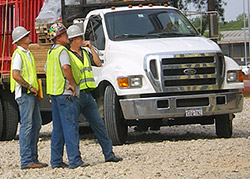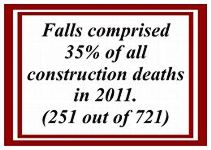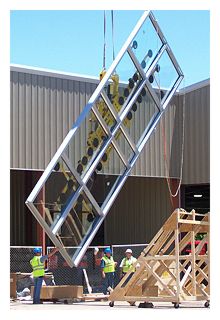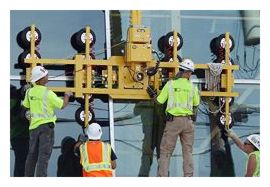OSHA's Fatal Four
Vacuum cup and below-the-hook vacuum lifter safety in the workplace
by Joe Landsverk At Wood's Powr-Grip® (WPG), we regularly receive calls from industrial safety managers requesting information about vacuum lifter safety and maintenance; and we are only too happy to help out in any way we can! It's good that there is a growing concern about worker and work place safety. According to the U.S. Dept of Labor's (DOL) Commonly Used Statistics, there were 4,609 U.S. workers killed on the job in 2011 - nearly 13 per day. It's encouraging that this is a 7% decrease from 2010! But even one fatality is too many. The information goes on to say: "Safety on the Job Site is a Paramount Consideration. Out of 4,114[1] worker fatalities in private industry in calendar year 2011, 721 or 17.5% were in construction. The leading causes of worker deaths on construction sites were falls, followed by electrocution, struck by object, and caught-in/between. These "Fatal Four" were responsible for nearly three out of five (57%) construction worker deaths in 2011[1], BLS [Bureau of Labor Statistics] reports. Eliminating the Fatal Four would save 410 workers' lives in America every year."
Well over half of the products manufactured by WPG are used in the construction industry. Vacuum cups and lifters are used extensively for installing windows, doors, building facades, counter tops, insulated metal panels, tile, appliances and countless other applications. In many ways, vacuum cups and below-the-hook (BTH) lifters are safety products in their own right: They provide quick and convenient ways to get a better grip on awkward loads, placing handlers at a more advantageous and safer distance from load, and in some cases, they take the weight of the load completely off of the handler. However, the purpose of this series is to provide information addressing OSHA's Fatal Four as they relate specifically to using vacuum attaching cups and below-the-hook lifters.
FALLS: (251 - 35% of the 721 fatalities in construction)
"Safety on the Job Site is a Paramount Consideration. Out of 4,114[1] worker fatalities in private industry in calendar year 2011, 721 or 17.5% were in construction. The leading causes of worker deaths on construction sites were falls, followed by electrocution, struck by object, and caught-in/between. These "Fatal Four" were responsible for nearly three out of five (57%) construction worker deaths in 2011[1], BLS [Bureau of Labor Statistics] reports. Eliminating the Fatal Four would save 410 workers' lives in America every year."
Well over half of the products manufactured by WPG are used in the construction industry. Vacuum cups and lifters are used extensively for installing windows, doors, building facades, counter tops, insulated metal panels, tile, appliances and countless other applications. In many ways, vacuum cups and below-the-hook (BTH) lifters are safety products in their own right: They provide quick and convenient ways to get a better grip on awkward loads, placing handlers at a more advantageous and safer distance from load, and in some cases, they take the weight of the load completely off of the handler. However, the purpose of this series is to provide information addressing OSHA's Fatal Four as they relate specifically to using vacuum attaching cups and below-the-hook lifters.
FALLS: (251 - 35% of the 721 fatalities in construction)

Whether you are working at height or at ground level, let's face it: It's dangerous work to handle awkward, large or heavy materials such as, glass, stone or metal! Sure, using vacuum attaching equipment helps workers to grip their loads more securely, but there are many other jobsite factors that influence slips, falls and knock-off accidents!
-
- Fall protection devices: When working above ground (6 feet [1.8 m] or more above lower level):
- Make sure that proper edge railings and decking is in place;
- Make sure personal fall arrest systems (PFAS) and anchors are in place, are regularly inspected, tested and correct for the working height;
- Don't use vacuum cups or lifters to support or secure people, unless they are specifically designed as fall protection devices.
- Fall protection devices: When working above ground (6 feet [1.8 m] or more above lower level):
- Lift and move plans: Always carefully inspect and plan the transfer route or fly zone prior to performing the actual lift. This helps prevent events that cause workers to slip, fall, get knocked over or knocked off above-ground structures.
- Manual lifting with hand-held vacuum cups:
- Level the path, remove tripping hazards and obstructions, and cover holes or openings;
- Know potential hazards, including wet/slippery areas, rugged or sloped terrain, overhangs and overhead obstructions;
- Identify resting or staging areas;
- Concentrate on the load, lifter and path during load movement;
- Use a spotter to warn of upcoming hazard areas and to keep bystanders at a distance.
- Powered lifting with below-the-hook lifters:
- Identify overhead power lines and other potential obstructions or hazards;
- Practice the route and fly zone to determine the safest and most efficient transfer;
- Don't lift a load higher than necessary or lift a load over people;
- Use tethers to control the load during the lift;
- Use spotters to watch load movement throughout the lift and warn handlers of potential hazards;
- Keep bystanders out of the lift/fly zone during the transfer, using tape or barricades;
- Don't leave suspended loads unattended;
- Know upcoming weather conditions and don't attempt lifts during windy or potentially windy conditions.
- Manual lifting with hand-held vacuum cups:
- Proper lifting techniques: Reduce slips and falls by making sure that workers know their own limits and are using tools and techniques that prevent an unexpected load movement or release. Such load incidents can cause workers or bystanders to lose their balance, resulting in falls and other injuries.
- Know how much weight you can safely lift;
- Don't lift loads that exceed a vacuum cup's maximum load capacity (WPG hand-held vacuum cups have maximum load capacities ranging between 15 lbs [7 kg] and 175 lbs [79 kg] per cup);
- Don't allow anything to interfere with free movement of a vacuum cup's plunger, and don't touch release tabs or the valve release lever during a lift;
- Don't lift when a vacuum cup's red line is visible and check the vacuum indicator frequently during the lift;
- Lift with your knees, not your back;
- Start and stop slowly; when two or more are lifting, use a count-down to begin the lift in unison;
- Check the attachment of vacuum cups under load before starting to walk;
- Avoid jarring or bumping the load during transfer;
- Don't allow people to ride on below-the-hook lifters or the load being lifted;
- Don't attempt to lift cracked or broken materials with below-the-hook lifters;
- Position a vacuum cup or below-the-hook lifter carefully, to prevent unexpected or accelerated shifts when the load is lifted, tilted or rotated.
Working with and around electricity can be dangerous. Fortunately, many vacuum lifters used in the construction industry are DC powered. Although such battery powered vacuum lifters operate without a power cord (except for charging the battery), many electrical hazards may still be associated with their use, the most obvious of which is coming in contact with electrical power. Being aware of the surroundings and avoiding power lines will help prevent accidental electrocution when using Wood's Powr-Grip Vacuum Lifters.
- Proper Prior Pre-planning (3-P's): As with nearly all job site activity, planning is key in the effort to prevent worker injuries.
- Prior to moving a load, conduct a walk-through of the planned route(s);
- Identify all possible energy sources.
- Compile a detailed lift plan and communicate it to all workers in the area.
- Use a lock-out/tag-out procedure.
- Whenever possible, before beginning work, disconnect any load circuits that present particularly hazardous situations, keeping in mind that turning power off may create other hazards. Such hazards and additional guidance should be addressed in your lift plan. Test the electrical system to ensure it has been de-energized.
- Select the appropriate personal protective equipment and use it until safely clear of electrical hazards.
- At any time during the lift, if potential hazards seem worse than expected, stop and revise the plan.
- Take extreme precaution around overhead power lines: Often difficult to see and sometimes outside of view, high voltage overhead power lines present particularly hazardous conditions when cranes, cables, scaffolding, ladders and other metal equipment make contact. When working near overhead power lines:

- Keep a safe distance between you, mechanical equipment and high-voltage power lines and ground any equipment, such as cranes, ladders and scaffolding that could become conductors;
- Isolate the vacuum lifter using non-conductive nylon web or synthetic slings between the lifter and metal crane cables or mechanical lifting device;
- Isolate yourself from the vacuum lifter using appropriately rated rubber gloves and footwear suitable for the voltages present;
- Avoid contact between you, the lifter or the load and any conductive material, surface or equipment. When you are on the ground, never lean on, support or move between equipment during a lift where cables, overhead cranes, ladders or scaffolding could come in contact with overhead power lines;
- Use spotters whenever moving loads near power lines, so the lifter and crane operator can focus directly on the load.
- Be aware of conditions and situations where hidden electrical dangers exist: Just because you don't see an electrical hazard doesn't mean it is not there.
- In addition to posing a slipping hazard, water is an excellent electrical conductor;
- Make sure that sources of standing water and electrical power are eliminated from the transfer path and from beneath ladders, scaffolding and hoists before moving a load;
- Make sure that all receptacles, power cords and connectors are properly grounded and kept dry and away from potential water sources;
- Make sure temporary electrical services installed outside of a building during early construction continue to be properly fused, grounded and protected from wet weather and water run-off;
- Thunderstorms and lightning strike fast and even well grounded cranes and other equipment can become a danger to nearby workers. Keep informed about approaching weather conditions. Remember, lightning can strike 10 miles or further ahead of a storm.
Inspection and Maintenance are Crucial when using Vacuum Lifters from Wood's Powr-Grip.There are thousands of ways to be struck by objects on a construction site, such as worker/vehicle collisions, falling tools or debris, flying projectiles, structure collapse, or pulling and prying incidents. Frequently these incidents involve more than one person. Being aware of our surrounding environment is critical to our own well being; but paramount is accepting responsibility for and taking the appropriate precautions to keep ourselves and others safe!
- Use equipment to protect yourself and others: This not only includes personal protective equipment (PPE), but also equipment designed to alert others! Check with your trade association for guidelines and best practices, as well as with trained safety personnel and equipment providers for specific information.
- Wear appropriate PPE for the material being handled, such as hardhats, gloves, footwear, and protection for ears, eyes and extremities.
- Alert others to your presence by barricading or cordoning off work areas to keep people out of the lifter's path or fly zone in the event of an unexpected load release. Of course, never lift a load over people or position yourself underneath a load.
- Use spotters when moving loads from one place to another, so the operator can focus directly on the load and lifter.
- Secure materials and tools with ropes or other tethers and employ debris nets, canopies, toe-boards, screens, etc. to prevent or deflect falling objects.
- Use the correct tool, know how to use it properly and perform maintenance and inspection: Vacuum attaching lifters, whether hand-held or below-the-hook, are available in a variety of models specially designed for specific handling applications. Knowing what lifter to use, how to use it and how to maintain it is imperative to prevent unexpected load shift or release.
- Select the right lifter in terms of load manipulation (rotation, tilt, etc.), load capacity, pad frame vs. load size, as well as vacuum pad type and compound.
- Read the lifter instructions! Not only do they include operational information, but they also include warnings particular to the device and important maintenance and inspection schedules designed to prevent unintentional load release.
- Perform all inspections and test prior to using the lifter under load.
- Make certain the contact surfaces of both the load and all vacuum pads are clean prior to bringing them into contact. Keep vacuum pad faces away from sharp edges or rough surfaces which can damage the sealing edges. This can cause the vacuum pads slip or disengage prematurely.
- Inspect chains, wire ropes, nylon web and synthetic slings and cables used to connect the lifter to the crane or overhead device in accordance with applicable ANSI B30.9 Guidelines.
- Environmental factors, such as elevation, wet/dry and hot/cold, affect the operation and capacity of vacuum lifters. Know the effects of adverse conditions and what measures must be taken to safely operate the equipment.
- Modifications to the lifter may compromise its safety; never operate a lifter that is damaged, malfunctioning, or missing parts.
- Never exceed the Load Capacity or attempt to lift loads the lifter is not designed for.
- Keep hands and fingers well away from release buttons or levers during a lift.
- Balance and secure the load.
- Positioning the pad frame on the load is critical. Off-center placement can cause unexpectedly quick movements when rotating or tilting a load. If rotation or tilt levers do not function properly, the load may be incorrectly positioned.
- Prior to releasing a load, make sure it is physically secured by tethering, clamping or affixing it in place.
 CAUGHT IN OR BETWEEN OBJECTS: (18 - 2% of the 721 construction fatalities in 2011)
CAUGHT IN OR BETWEEN OBJECTS: (18 - 2% of the 721 construction fatalities in 2011)
OSHA defines caught-in or caught-between injuries as those resulting from workers being squeezed, caught, crushed, pinched, or compressed between two or more objects, or between parts of an object. Examples include trench cave-ins, being pulled into or caught by clothing in rotating machinery, being crushed between rolling, sliding, or shifting objects such as between semi-trailers and dock walls, between pallets and forklifts or between overhangs and crane arms or cables.
Using vacuum attaching equipment on the job site, in the shop or warehouse can pose unique hazards. To untrained or inattentive workers, the most common hazard is being crushed by tipping racks, crates or materials.
Strangely, the same principle vacuum lifters use to attach and lift a load can be the cause! Sheet, plate or slab materials, such as glass, metal or stone, are often packaged, transported and stored tightly against each other. When materials like these are separated, a vacuum, surface tension or static electrical charge can develop between material surfaces. A related hazard, called "after-stick", occurs when vacuum cups or below-the-hook vacuum lifters are tugged or pulled away from the load before the vacuum is completely released between the vacuum pad and the material. These hazards can cause the material, the entire rack, stack or case to tip forward and crush workers in between or underneath the material. This can result in multiple broken bones, asphyxiation, or death.
One of the advantages vacuum lifters provide is that load edges are left unobstructed by clamps, straps or other parts enabling loads of all shapes, sizes and weights to be quickly, easily and precisely moved into place in tight areas, fixtures or frames. However, crushing, pinching, dismemberment and even death can occur if workers are inattentive or distracted during critical placement activities.
- Proper Prior Planning:As with nearly all job site activity, planning is the key to preventing worker injuries. Keep in mind that each step of a load transfer has different kinds of hazards.
- Read the lifter instructions! Not only do they include operational information, they also include warnings particular to the device and situations where hazards may exist;
- Ensure the lifter works properly by following the maintenance and testing procedures;
- Locate pinch points and other areas of concern on the lifting equipment and other machinery which could crush extremities or draw you into the equipment.
- Prior to moving a load, conduct a thorough walk-through of the planned route(s);
- Compile a detailed lift plan and communicate it to all workers in the area;
- Establish a clear and easily identifiable route for workers and others to pass from place to place without passing under, over, behind, or between equipment or vehicles that pose potential hazards;
- At any time during the lift, if potential hazards seem worse than expected, stop and revise the plan.
- Read the lifter instructions! Not only do they include operational information, they also include warnings particular to the device and situations where hazards may exist;
- Use equipment to protect yourself and others:This includes not only using personal protective equipment (PPE), but also knowing how to use it correctly and making sure everything is operational. Check with your trade association for guidelines and best practices, as well as with trained safety personnel and equipment providers for specific information.
- Wear appropriate PPE for the material being handled, such as hardhats, gloves, footwear, ear, eye, and extremity protection;
- Never place your hands or body near moving parts. Should this become necessary, make sure the device is properly guarded. Secure or remove loose fitting clothes, gloves, long sleeve shirts or jewelry, which could draw you in if caught in moving parts.
- Maintain safe working distances:
- Don't get between heavy machinery, moving loads and stationary objects or structures;
- Never work within or travel through the swing radius of rotating or pivoting equipment, such as cranes, booms and man-lifts;
- Alert others to potential risk by barricading or cordoning off work areas to keep them out of the lifter's fly zone, drop zone and swing radius of rotating or pivoting equipment;
- Use spotters when moving loads and machinery from one place to another, so the operator can focus directly on the load and lifter;
- Be extremely cautious, alert and conscious of your surroundings during the entire lift;
- Use correct tools and procedures: Check with your trade association for guidelines and best practices, as well as with trained safety personnel and equipment providers for specific information.
- Firmly secure the rack, crate or other device from which the load will be lifted;
- Use appropriate tools or procedures to break the surface vacuum between the load and remaining materials. Secure the remaining sheets or slabs using clamps or braces;
- Make sure the lifter is completely attached! Pressing a lifter against or lowering a lifter onto a load can create the impression that the lifter is attached to the load. Wait until vacuum reaches the designated level and safe lift indicators display correctly before beginning a lift;
- Position the pad frame on the load as directed in the instructions. This is critical because off-center placement can cause unexpectedly quick movements when rotating or tilting a load;
- After the load is in position and prior to releasing vacuum, make sure the load is physically secured by tethering, clamping or affixing it in place.
Joe Landsverk was the Marketing Manager at Wood's Powr-Grip. He served for over 25 years, overseeing the company's day-to-day marketing and advertising activities.
